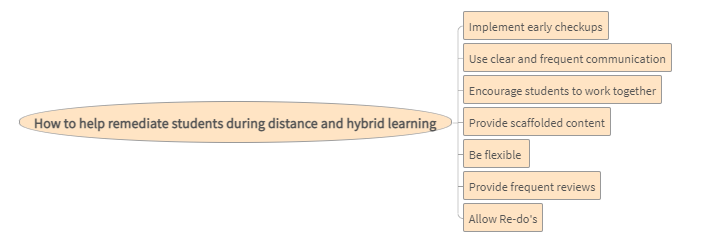Teaching students online either using a hybrid model or distance learning can be difficult for educators and students alike. Unlike traditional learning, noticing that students are struggling can take a bit more time and effort when working online. The common confused looks, hands in the air, and other signs that students need help are not visible when students are learning from home. One may ask: what can I do to help my hybrid and distance learners be successful when they are struggling with content? 
- Implement early check-ups. Use a variety of formative assessments to gauge students’ understanding of content. Frequent use of different assessments can provide clarification of when/if students are struggling with content. When misconceptions are noted, steps can be taken to help the student accurately understand the content. Without assessments, it is difficult to know what students know. The use of early check-ups can help prevent students from getting too far off track and requiring additional remediation.
- Use clear and frequent communication. Communication is one of the most important tools an educator uses. Clearly, hybrid and distance learning models require that communication to look differently, but it is still equally important. After noticing a student is struggling with content, assess how to better communicate with him or her in a more individualized manner. This could be through emails, a one-on-one Zoom session, or other methods that allow the teacher and student to work together to build understanding and clarity.
- Encourage students to work together. By building a sense of community, learners can work together to help each other understand difficult content. This method may require breakout rooms or other small group online activities. Peer teaching is a powerful tool. Sometimes students are more open to listening to a peer explain concepts that they are struggling to understand. Building online peer communication can be a powerful remediation tool.
- Provide scaffolded content. Building lessons in a scaffolded manner can aid students in understanding difficult concepts. This method can also be a powerful reteaching tool. When looking at students’ formative assessment results, discern where they are struggling and then work to create a more scaffolded, step-by-step approach to aid them in reviewing the content in a different way.
- Be flexible. Distance and hybrid learning are difficult and new to many educators, students, and parents alike. Be flexible. Provide extra time when students reach out asking for clarification or needing additional support to complete an assignment.
- Provide frequent reviews. Using well-spaced reviews has always been one of a teacher’s greatest tools, distance and hybrid learning are no different. Use reviews to make sure students are continuing to recall important knowledge from previous lessons and units.
- Allow “Re-dos”. At times, teachers ask students to show them their work in class before they turn it in. This is a bit more difficult when working in an online setting; nonetheless, redos are still important. After looking at students’ work, send comments and feedback that will enable the student to redo their work while applying the provided feedback.

